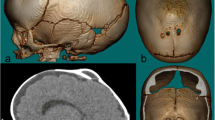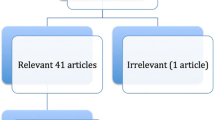Abstract
Cephalohematoma is a common pathology in newborns. Observation is the primary treatment for most patients with small uncomplicated cephalohematoma. Conversely, a large cephalohematoma can lead to calcification with unesthetic local deformation or deformational plagiocephaly. The objective of the study was to evaluate the iatrogenic risk associated with early puncture under local anesthesia and oral sucrose. This is a retrospective study of 67 consecutive newborns followed at Montpellier University Hospital, France, between 2010 and 2017. Large cephalohematoma was defined on the basis of the bump projection. Due to the uncertainty of the spontaneous resorption and the risk of calcification after 4 weeks which render the needle aspiration ineffective, puncture was performed between 2 and 4 weeks of life after coagulation evaluation and ultrasound of the skull and scalp. Puncture was performed in 43 boys (64%) and 24 (36%) girls between day 15 and day 30 after birth. The cephalohematoma maximal projection measured by ultrasound ranged from 9 to 13 mm (Q1,Q4) with a median value of 12 mm. No puncture-related complication was recorded during the intervention and at the 1-month follow-up visit.
Conclusion: In newborns with large and persistent unesthetic cephalohematoma, puncture under local anesthesia with oral sucrose can be safely proposed between day 15 and day 30 after birth.
What is Known: • Infant cephalohematoma is a frequent pathology of newborns, consisting of a traumatic subperiosteal hematoma of the skull. Most cephalohematomas are small and require no treatment because they spontaneously disappear within the first month. • Large and non-resorptive cephalohematomas may have significant esthetic and functional consequences. What is New: • Early puncture under local anesthesia is a safe, effective, and rapid procedure, decreasing the risk of persistent skull deformities. • Puncture can be proposed for newborns with a large (high projection and/or high angle connection) persistent anesthetic cephalohematoma, between day 15 and day 30, before spontaneous calcification. |



Similar content being viewed by others
References
Thacker KE, Lim T, Drew JH (1987) Cephalhaematoma: a 10-year review. Aust N Z J Obstet Gynaecol 27(3):210
Yasunaga S, Rivera R (1974) Cephalhematoma in the newborn. Clin Pediatr (Phila) 13(3):256–260
Mangurten HH (2006) Birth injuries. In: Martin RJ, Fanaroff AA, Walsh MC (eds) Neonatal-perinatal medicine: diseases of the fetus and infant. Philadelphia, PA :Elsevier/Saunders, pp 531–535
Nicholson L (2007) Caput succedaneum and cephalohematoma: the cs that leave bumps on the head. Neonatal Netw 26(5):277–281
Petrikovsky BM, Schneider E, Smith-Levitin M, Gross B (1998) Cephalhematoma and caput succedaneum: do they always occur in labor? Am J Obstet Gynecol 179(4):906–908
Zakanj Z (2014) Skull fracture and cephalhematoma in a newborn-a case report. Lijec Vjesn 136(11-12):335–338
Kendall N, Woloshin H (1952) Cephalhematoma associated with fracture of the skull. J Pediatr 41(2):125–132
Blom NA, Vreede WB (1993) Infected cephalhematomas associated with osteomyelitis, sepsis and meningitis. Pediatr Infect Dis J 12(12):1015–1017
Wong CS, Cheah FC (2012) Cephalhematoma infected by Escherichia coli presenting as an extensive scalp abscess. J Pediatr Surg 47(12):2336–2340
Bansal A, Bothra GC, Verma CR (1985) Hyperbilirubinemia due to massive cephalhematoma. Indian Pediatr 22(8):619–621
Balmes J, Pujol H (1953) Cephalhematoma of the newborn and maternal and fetal thrombocytopenia. Montpellier Med 44(4):282–286
Leonard S, Anthony B (1961) Giant cephalhematoma of newborn: with hemorrhagic disease and hyperbilirubinemia. Am J Dis Children 101(2):170–173
Ciurea AV, Gorgan MR, Tascu A, Sandu AM, Rizea RE (2011) Traumatic brain injury in infants and toddlers, 0–3 years old. J Med Life 4(3):234–243
Paul SP, Goodman A (2011) Potential complications of neonatal cephalhaematoma in the community: when to refer to the paediatric team? J Fam Health Care 21(1):16–19
Daglioglu E, Okay O, Hatipoglu HG, Dalgic A, Ergungor F (2010) Spontaneous resolution of calcified cephalhematomas of infancy: report of two cases. Turk Neurosurg 20(1):96–99
Guclu B, Yalcinkaya U, Kazanci B, Adilay U, Ekici MA (2012) Diagnosis and treatment of ossified cephalhematoma. J Craniofac Surg 23(5):e505–e507
Yoon SD, Cho BM, Oh SM, Park SH (2013) Spontaneous resorption of calcified cephalhematoma in a 9-month-old child: case report. Childs Nerv Syst 29(3):517–519
Firlik KS, Adelson PD (1999) Large chronic cephalohematoma without calcification. Pediatr Neurosurg 30(1):39–42
Gupta PK, Mathew GS, Malik AK, Al Derazi T (2007) Ossified cephalhematoma. Pediatr Neurosurg 43(6):492–497
Matsuda E (2017) Sucrose as analgesia in neonates undergoing painful procedures. Am J Nurs 117(8):21
Unrein H (1970) Conservative or surgical treatment of cephalhematoma. Kinderarztl Prax 38(12):552
Eseonu CI, Sacino AN, Ahn ES (2016) Early surgical intervention for a large newborn cephalohematoma. Pediatr Neurosurg 51(4):210–213
Brockel MA, Polaner DM, Vemulakonda VM (2018) Anesthesia in the pediatric patient. Urol Clinic N Am 45(4):551–560
Cepeda M, Tzortzopoulou A, Thackrey M et al (2010) Adjusting the pH of lidocaine for reducing pain on injection. Cochrane Database Syst Rev 12:CD006581
Chung HY, Chung JY, Lee DG, Yang JD, Baik BS, Hwang SG, Cho BC (2004) Surgical treatment of ossified cephalhematoma. J Craniofac Surg 15(5):774–779
Liu L, Dong C, Chen L (2016) Surgical treatment of ossified cephalhematoma: a case report and review of the literature. World Neurosurg 96:614.e7–614.e9
Acknowledgements
The authors thank Drs Farid Bekara, Florian Boissière, and Julien Gibrila for the assistance they provide in the management of the patients of this study.
Author information
Authors and Affiliations
Contributions
FB drafted the article, collected the data and supported the analysis. MB and AL provided useful comments on the article. GC co-ordinated the project, completed the analysi, provided background information and valided the final article.
Corresponding author
Ethics declarations
Conflicts of interest
The authors declare that they have no conflict of interest.
Ethical approval retrospective studies
The study had local review board approval from the Montpellier University Hospital research ethics committee.
Additional information
Communicated by Piet Leroy
Publisher’s note
Springer Nature remains neutral with regard to jurisdictional claims in published maps and institutional affiliations.
Rights and permissions
About this article
Cite this article
Blanc, F., Bigorre, M., Lamouroux, A. et al. Early needle aspiration of large infant cephalohematoma: a safe procedure to avoid esthetic complications. Eur J Pediatr 179, 265–269 (2020). https://doi.org/10.1007/s00431-019-03487-5
Received:
Revised:
Accepted:
Published:
Issue Date:
DOI: https://doi.org/10.1007/s00431-019-03487-5




